Introduction: Where do you begin?
Unless a person has been reading comic books for over forty years… they have come to the X-Men late. Created by Stan Lee and Jack Kirby in 1963, the X-Men have enjoyed over five decades of stories, leading to five decades of history and continuity. For someone coming to the world of the X-Men today, they have to face an almost overwhelming sense of being behind on their first day of enjoying the franchise.
This article will attempt to give newcomers a point of reference for the dozens upon dozens of X-Men related titles which have been published since the first series' debut in the early sixties. While storylines and major events will only be touched upon briefly, it's the goal of the following text to show how each series as a whole fits in relation to the others in the greater publication timeline of the X-Men. Keep in mind, there is no right or wrong way to approach reading the X-Men titles or the thousands of appearances by their characters in the past. Hopefully, this primer will aid newcomers in finding what is the best way for them to proceed.
Chapter 1: 1963 – a less successful creation 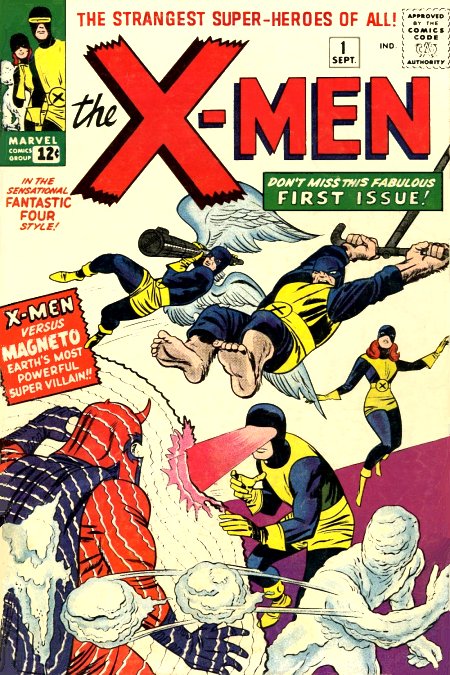
The early 1960s were a Renaissance of comics, what is known today as the heart of the “Silver Age” of comics. At the center of this era was the surge of Marvel Comics, led by the creative geniuses of Stan Lee and Jack Kirby. Among theirs and other Marvel creators’ creations were the Fantastic Four, the Incredible Hulk, the Amazing Spider-Man, Daredevil, Thor, the Avengers and more.
It was in these early years that the X-Men were created. Purportedly, Stan Lee came up with the idea of “mutants” – humans born with a special “X-factor” in their genetic makeup which gave them super-powers – because he had such a hard time coming up with explanations on how the heroes and villains obtained their powers.
At the same time, Lee and Kirby came up with science fiction analogues for real-world social problems: racism. While the heroes of the Marvel Universe had their share of angst, the mutant heroes had to deal with hatred for “their kind.” Unlike heroes who gained their powers through cosmic rays or radioactive spiders, the general populace was wary of mutants – so called “Homo superior,” who claimed to be humanity’s next evolutionary step. Like humanity supplanted Neanderthals, mutants seemed to be what would replace Homo sapiens.
Over the last five decades, the back history of the X-Men and their founder, Professor Charles Xavier, would be explored and explained. However, when the X-Men first appeared in the fall of 1963, the comic had a rather simple premise: the mysterious and demanding “Professor X” ran a school for teenage mutants, who doubled as the X-Men.
The X-Men first appeared in the series simply called “X-Men.” It was not until years later that the adjective of “Uncanny” was added before it. Years after that in 1991 a second X-Men title was started, again simply called “X-Men.” As a result, the title which began in 1963 and exists today as Uncanny X-Men will be referred to hereon as X-Men (1st series) prior to #142 (when it officially changed names) and the title which began in 1991 as X-Men (2nd series). Even more confusing, that first title, which became Uncanny X-Men, technically became Uncanny X-Men (1st series) when it was replaced by a 2nd series of that name in 2010.
Over their first few years of publication, X-Men (1st series) introduced all of what many might consider the “classic” villains in the X-Men’s rogue’s gallery: Magneto, the Brotherhood of Evil Mutants, the Blob, the Sentinels and the Juggernaut. Probably not coincidentally, further “classic” villains stopped appearing after #17, which marked the last contribution of Jack Kirby to the title.
While the X-Men were indeed one of Lee & Kirby’s creations, they definitely seemed less inspired to Marvel readers of the day, almost being that “other” title. Sales were so poor that the series was cancelled with #66. Nine months later, the series again graced newstands, but instead of publishing new stories it merely reprinted earlier issues. This would continue until #93.
Between their first appearance in 1963 to the title’s cancellation in 1970, the X-Men had included Professor X, Cyclops, Marvel Girl, Beast, Iceman, Angel – later including Mimic, Havok, Lorna Dane (later called Polaris) and (albeit in a confusing, retroactive manner) the Changeling.
Chapter 2: 1975 – “New” X-Men, from second-rate to flagship status
As mediocre as the X-Men’s first decade of publication was, the spotlight of the world of comics changed with the release of Giant-Sized X-Men #1. In this one-shot, Cyclops and Professor X put together a new group of X-Men to rescue the old from a mission gone bad. Among this group were Banshee, Colossus, Nightcrawler, Storm, Sunfire, Thunderbird & Wolverine. Shortly after the special’s publication, the X-Men title resumed with #94, written by Chris Claremont. For the next fifteen years, Claremont’s name would be synonymous with the X-Men, as he had an uninterrupted run of writing the X-Men (albeit occasionally with co-writers and co-plotters), from #94 to #279.
As the title returned with #94, most of the old X-Men left, with only Cyclops remaining. Sunfire departed immediately, not wanting to be a part of the team, and Thunderbird died during the X-Men’s second mission. However, with the exception of Banshee leaving in #129 and the addition of Shadowcat (and temporary return of the Angel), the ranks of the X-Men stayed stable for a few years.
During these years, the X-Men grew in popularity, becoming a powerhouse in terms of sales and storylines. The storyline of the Phoenix began shortly after the “new” X-Men’s re-launch, with #101, as Jean Grey seemingly died, only to be resurrected into a cosmic power level entity, called the Phoenix. While later continuity would change this storyline slightly, Chris Claremont and John Byrne (who was co-plotting the series at the time) would lead to the much lauded “Dark Phoenix Saga,” where ultimate power corrupted Phoenix into a malevolent threat so powerful that she could only be stopped by her own hand.
It was during this time that several mainstay X-characters were added, such as Shadowcat, Rogue (the first permanently reformed X-villain!) and Rachel Summers, later known as Phoenix III and later still as Marvel Girl III. Also introduced were such reoccurring villains as Mystique and her Brotherhood of Evil Mutants, the Morlocks, the alien Brood, the Hellfire Club and Nimrod.
Chapter 3: mid to late 1980s – the franchise begins
 As it was almost inevitable, the success of the X-Men caused Marvel to become interested in expanding the mutant franchise. Although originally not conceived as such, in retrospect Dazzler's own series can be seen as the X-Men's first spin-off series. With this title, Marvel was aiming for a female, music-interested audience, and had the character do some promo-appearances in some of their most successful books (Fantastic Four, Amazing Spider-Man) before her own book started. The fact that Dazzler was a mutant was only of minor importance in the beginning; it was just an easy way to explain her powers. However, it's this tiny bit that made it into the records: Dazzler actually being the first “mutant” ongoing solo title - long before Wolverine even had a limited series.
As it was almost inevitable, the success of the X-Men caused Marvel to become interested in expanding the mutant franchise. Although originally not conceived as such, in retrospect Dazzler's own series can be seen as the X-Men's first spin-off series. With this title, Marvel was aiming for a female, music-interested audience, and had the character do some promo-appearances in some of their most successful books (Fantastic Four, Amazing Spider-Man) before her own book started. The fact that Dazzler was a mutant was only of minor importance in the beginning; it was just an easy way to explain her powers. However, it's this tiny bit that made it into the records: Dazzler actually being the first “mutant” ongoing solo title - long before Wolverine even had a limited series.
As time passed, Dazzler's status as a mutant became being more and more emphasized, for instance in the Graphic Novel that appeared along the 42 regular issues. Later, the character eventually turned her back on singing, fully becoming a superheroine. As she officially joined the X-Men in Uncanny X-Men (1st series) #213-214, a short while after her own series' cancellation, Dazzler had come full circle since her first appearance in X-Men (1st series) #130-131, in which she had refused membership.
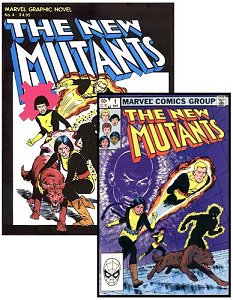 The second spin-off was the first New Mutants series. During the storyline from Uncanny X-Men (1st series) #161 to #166, which took the X-Men to the stars to fight against the alien Brood, circumstances forced Professor X to enroll a new group of students to his school. These “new” mutants first appeared in Marvel Graphic Novel #4 in 1982, which led to their own series in March of 1983.
The second spin-off was the first New Mutants series. During the storyline from Uncanny X-Men (1st series) #161 to #166, which took the X-Men to the stars to fight against the alien Brood, circumstances forced Professor X to enroll a new group of students to his school. These “new” mutants first appeared in Marvel Graphic Novel #4 in 1982, which led to their own series in March of 1983.
The initial New Mutants were Cannonball, Karma, Psyche (later called Mirage), Sunspot & Wolfsbane. Over the next hundred issues, they were joined by Cypher, Magik, Warlock, Magma, Boom Boom, Rusty, Skids & Rictor. During the series’ run, these youths grew in maturity, thanks to the mentoring of three different teachers. Their first was their founder, Charles Xavier. However, when circumstances led to his departure, the group fell under the tutelage of Xavier’s former enemy, Magneto, who had recently reformed. Unfortunately, when Magneto was unable to fulfill his charge, the group wandered on their own until being taken under the wing of the enigmatic Cable, who quickly began to transform them into a more militaristic fighting squad. It was in the spirit of this change that the series ended with #100 in 1991, to be replaced a few months later by the first X-Force series.
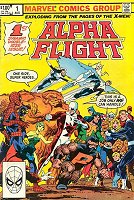 Another early eighties series was the first Alpha Flight series. Not only did they make their public debut in X-Men (1st series) #120, but they were also connected to Wolverine, as the Canadian mutant had worked for Department H’s Flight Program before joining the X-Men. While Alpha Flight kind of belongs to the X-franchise because of the large number of mutants among their ranks, the book actually contained elements of Marvel’s three major team books. Just like the Avengers, Alpha Flight had ties to their government and counted gods, mystics, agile superhumans and inventive minds in self-designed battle armors among their ranks. From the Fantastic Four, Alpha Flight kind of adopted the certain family feel, with several members being related to each other or having been close friends for a lifetime.
Another early eighties series was the first Alpha Flight series. Not only did they make their public debut in X-Men (1st series) #120, but they were also connected to Wolverine, as the Canadian mutant had worked for Department H’s Flight Program before joining the X-Men. While Alpha Flight kind of belongs to the X-franchise because of the large number of mutants among their ranks, the book actually contained elements of Marvel’s three major team books. Just like the Avengers, Alpha Flight had ties to their government and counted gods, mystics, agile superhumans and inventive minds in self-designed battle armors among their ranks. From the Fantastic Four, Alpha Flight kind of adopted the certain family feel, with several members being related to each other or having been close friends for a lifetime.
The first Alpha Flight series ran for an impressive 130 issues, from 1983 to 1994. During this time, the series developed a die-hard fan base, who liked the intricate continuity that had developed over the years. However, the most defining era will always be the first 28 issues, written and penciled by John Byrne. While the man himself doesn’t think that highly of his own work on Alpha Flight, it’s he who laid the groundwork for years of story potential, creating characters such as Marvel’s first openly homosexual superhero, or a mutant suffering from a dissociative personality disorder, with her different identities despising each other. Although a second Alpha Flight series would run for 20 issues from August 1997 to March 1999, and a third ran for 12 issues, from May 2004 to April 2005, and a fourth one in 2011, none of them could capture the audience’s attention for long. Most approaches left out most of the classic Alpha Flight members and made use of a bunch of newbies instead, resulting in the fans feeling kind of cheated, this not being the “Alpha Flight” they wanted to read about. While all original characters returned in the most recent series in 2011, the characters were unfamiliar to most contemporary readers.
The original Alphans at the beginning of the series were Guardian (James Hudson), Shaman, Snowbird, Sasquatch, Aurora, Northstar, Puck & Marrina. The later members of this series and the two that followed were Talisman II, Box (Roger Bochs), Vindicator II (Heather Hudson), Madison Jeffries, Diamond Lil, Windshear, Wild Child, Guardian IV (the de-aged clone), Manbot, Radius, Flex II, Murmur III, Sasquatch II, Earthmover, Yukon Jack, Nemesis III, Puck II, Major Mapleleaf II, Centennial – definitely a complicated cast.
 Yet another new series was, in a way, an homage to the original X-Men… by bringing all of them back together again. Since the “new” X-Men were formed, the original X-Men had been separated and, after Cyclops left the team in Uncanny X-Men (1st series) #201, there were no members of the original team in the title.
Yet another new series was, in a way, an homage to the original X-Men… by bringing all of them back together again. Since the “new” X-Men were formed, the original X-Men had been separated and, after Cyclops left the team in Uncanny X-Men (1st series) #201, there were no members of the original team in the title.
However, reunite they would when, after years of believing Jean dead, the group learned that the entity calling herself Phoenix had only been a cosmic duplicate and that Jean had lain beneath the sea in a healing cocoon. Back together, the quintet formed the organization called X-Factor, which acted publically an all-human, mutant-hunting company but operated clandestinely as a sanctuary for mutant youths whom they rescued. Much like Xavier had taught them before, the X-Factor team acted as mentors to a new generation.
X-Factor’s duplicitous time as both mutant-hunting company and the “renegade mutant” group known as the X-Terminators (a name later adopted by their wards) was short-lived. The group soon revealed themselves to the public and quickly became regarded as heroes to the city. Eventually, events would conspire to reunite these former X-Men with their estranged, current counterparts, but for the first 69 issues X-Factor faced several threats on their own and were actually the first to do so against the menace of Apocalypse. It was at the hands of this adversary that one of their own, the Angel, was transformed into the Archangel, an event which has affected that character to this day.
With #70 of the series, the title changed in focus, but would continue until #149, after which it was canceled. Years after this, the title (in name only) would be resurrected in 2002 as a four-issue mini-series featuring all new characters. This was followed in 2005 by a new ongoing series, which lasted in one form or another near continuously until 2015.
By 1986, over ten years had passed since the “all-new, all-different” X-Men had appeared in Giant-Sized X-Men #1 and the X-Men title had been re-launched with X-Men (1st series) #94. 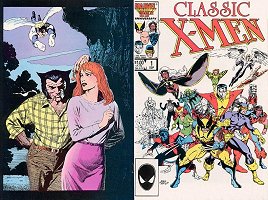 In order to bring a new generation of readers in on the growing history of the new X-Men, Marvel began a series simply called “Classic X-Men” in September 1986.
In order to bring a new generation of readers in on the growing history of the new X-Men, Marvel began a series simply called “Classic X-Men” in September 1986.
The first issue of this series partially reprinted Giant-Sized X-Men #1, with the second and subsequent issues reprinting X-Men (1st series) #94 and onwards. For bonus materials, as well having new covers, some issues included additional pages of artwork. Also, for the first 44 issues, there were additional, original stories, running for about eight pages each. Each of these short tales took place around the time of the story reprinted in that issue, giving a glimpse at what was going on behind the scenes for the characters at that time. Another change which occurred with the series was that, as of #46, the title of the series changed from Classic X-Men to X-Men Classic. This was part of an effort by Marvel to group as many X-titles as possible together on the sales rack. The series ran for a total of 110 issues, ending in July 1995 with the reprint of Uncanny X-Men (1st series) #206.
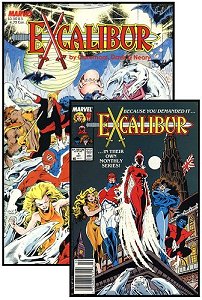 Two new series began in 1988. The first, Excalibur, included three former X-Men and two characters from Marvel’s UK franchise. Shortly before and after the Mutant Massacre storyline in Uncanny X-Men, Nightcrawler, Phoenix & Shadowcat were forced to leave the team. After a period of recuperation, the three were drawn into an adventure with Captain Britain and Meggan of Marvel UK in Excalibur: The Sword is Drawn, which had been published in 1987. In October 1988, the ongoing series began, which would last for 125 issues.
Two new series began in 1988. The first, Excalibur, included three former X-Men and two characters from Marvel’s UK franchise. Shortly before and after the Mutant Massacre storyline in Uncanny X-Men, Nightcrawler, Phoenix & Shadowcat were forced to leave the team. After a period of recuperation, the three were drawn into an adventure with Captain Britain and Meggan of Marvel UK in Excalibur: The Sword is Drawn, which had been published in 1987. In October 1988, the ongoing series began, which would last for 125 issues.
During this run, Excalibur would try to carve its own section of the X-universe, relying heavily on themes and characters from the “Marvel UK” line, of which few readers outside of the UK were familiar. Also, in contrast to the “dark and gritty” themes of the X-Men, Excalibur was a much more light-hearted title, though not exactly a humor book. Further, for the first 50 issues of the title, Excalibur intersected very little with the rest of the Marvel Universe, though its connectivity grew with the later addition of members Colossus, Wolfsbane, Douglock and Daytripper. The wholly original character of Pete Wisdom was also a later addition and one which became a recurrent character in other titles after the series’ cancellation with #125 in 1998.
The series was eventually followed with another Excalibur title in 2001, in actuality a miniseries, which was originally solicited as “Excalibur: Sword of Power.” However, as this title appeared in neither the incidia nor on the cover, it is considered as Excalibur (2nd series). This was followed by an ongoing Excalibur (3rd series), a short-lived ongoing series which ran for 14 issues in 2004-2005 and then by another ongoing (and again short-lived) series called “New Excalibur,” which began in 2005, lasting 24 issues.
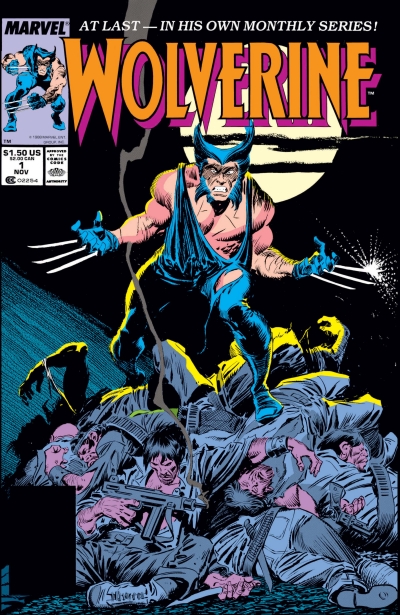 The second series that began in 1988 was the first ongoing Wolverine series. The most popular of the X-Men, Wolverine had already had a four issue miniseries in 1982, which made the ongoing series Wolverine (2nd series).
The second series that began in 1988 was the first ongoing Wolverine series. The most popular of the X-Men, Wolverine had already had a four issue miniseries in 1982, which made the ongoing series Wolverine (2nd series).
For the first 30 issues, the focus of the book was Wolverine’s exploits in the small island nation of Madripoor, in which Wolverine had adopted the identity of “Patch.” Beginning with #31, however, the title began to focus more on Wolverine’s past, beginning to explore his memories and causing him to question which of them were real and which possibly fabricated. It was also during this era that his past with Silver Fox and his time as a government agent in the 1960s was explored. Many of these stories can almost be viewed as a precursor to the Wolverine Origins series, many years later.
By the time of the publication of #75, which began Wolverine’s time without adamantium being bonded to his skeleton (a situation remedied in #145), the title lacked a particular direction or theme. Instead, it was mainly a title that depicted solo adventures of Wolverine during times he was not acting as a member of the X-Men. This series ran for a total 189 issues and was replaced with a third series in May 2003.


